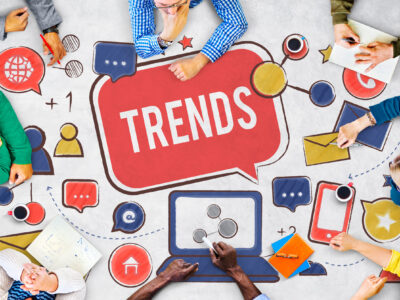We’re a week into 2021 and it’s anyone’s guess as to how this year will shake out after 2020. We carry on. We pivot. We shift our strategies and we plan ahead. Though there is trepidation among many on how much planning can be done and into which baskets to place our proverbial eggs, there are things we have learned during the past 12 months that will shape us this year.
Here are my 8 predictions and what I suggest will be best practices for marketing success as we head into the new year.
Real-time, real issues over noise
I need to start here because just moments ago we re-scheduled and re-focused our afternoon social media content due to the US Capitol lock-down situation. It’s not the time to talk about our brand or anything else; creating noise during times of turmoil or other historical instances is not a path we want to go down.
Your content strategy has nothing on the real issues. Each year brands are smarter and more respectful of this. Organic content creation including sensitivity to current issues and events needs to be top of mind. If you are going to be in the digital marketing space, this is something to be extremely mindful of. Real-time listening, engagement and ‘pause’ will be critical for brands’ digital presence and reputations.
Showcased brand personalities and values
Along with real-time issues comes the expectation that companies showcase their values in all that they do and take stands where appropriate. Your social media channels, your website, your general story lines should reflect this. If 2020 taught us anything it was around both resilience and the power to change–however that fits for you. Through Black Lives Matter, COVID-19, economic opportunities and brands as activists, many companies have shifted ways in which they share their stories and support their communities.
In fact, Engage for Good reports the following:
- 85% of Americans expect companies to help address racial inequality
- 89% of consumers say they want brands to shift money and resources to produce products that help people meet pandemic-related challenges
- 72% of Americans say they feel it is more important than ever that the companies they buy from reflect their values
Be honest. Don’t beat around the bush. Adapt your visuals, your content and your cadence to the world around you; focus on helping. Truth is, companies have a stage from which to either project positive, helpful messaging or messaging that adds to the noise. Which do you want to be a part of this year?
Focused digital channels
Or, cleaning house. I’m talking about stripping down how many digital channels brands use; keeping up with only the most relevant social media channels and being OK with dismissing others.
With so many digital channels to choose from, how can you be great at them all? Unless you have a huge digital team, you can’t.
Social media usage was up in 2020 due to the global pandemic, due to more work-from-home scenarios, furloughs and other situations that gave opportunities of time to those who didn’t have it before. Couple that with stay-at-home orders and screen time was at an all-time high.
And so was the noise.
There was so much going on across every. single. channel. How do brands keep up?
Digital fatigue is real and this year, brands that take a step back from the noise can still make waves. We don’t need ‘more’ of everything; we need concentrated value and content that serves a purpose to both engage our customers and drive our businesses. It’s like personal resolutions of being OK with saying “no”. The same holds true when determining the best distribution channels for your company. More is not always better.
Geographical market expansions
As companies become more comfortable with remote work environments and develop successful processes for staying engaged with customers, we will start to see companies based in local markets start to expand into areas where they were unable to in years prior. Companies that relied on brick-and-mortar sales have already worked to move those sales online and with that comes opportunities for geographical expansions.
The same holds true in the service industry and business-to-business sectors. Continue to utilize video conferencing tools and livestreams to bolster sales and reach those you thought may not have been previously possible.
Hybrid events and experiences
Virtual events are not new, but the speed in which they were produced and the quantity of them in 2020 was amazing. Hybrid and virtual events are here to stay. For one, they are easier to plan and two, when done well, you can engage larger audiences than you may have been able to from a standalone in-person event.
This year, organizations that take virtual events to the next level will win out. Move beyond pre-recorded content and be OK with livestreams and hybrid programming. Sure, things can go wrong during a livestream event, but the same holds true for in-person events and we weren’t stopping ourselves when those were all the rage, right?
This year, we’ll see virtual events focused on full-on experiences starting with registration up through event day. Home-delivered event kits, interactive virtual tradeshow halls, live speaker Q&As, break-out rooms and digital hot seats; we’ll witness these ideas become bigger and better as we engage in events that may not have been possible in years past due to location, budgets or otherwise.
Increased influencer marketing
DIY videos, self-care, how-to podcasts; we’ve all been known to go down those paths as we bide our time during pandemic lock downs and stay-at-home mandates. We want to see and hear others using products and services of interest to us.
Enter: influencer marketing.
Though not new, influencer marketing was huge in 2020 and Business Insider projects it as being on track to be a $15 billion dollar industry by 2022. It’s word-of-mouth. It’s social proof. It’s trusting peers. It’s a way for brands to connect with audiences on the right channels, with messaging from the right (trusted) sources.
A word of caution: If you enter into influencer marketing agreements, vet your influencers and ensure that all values align. Though we’ve seen a trend here, we also know that consumers are skeptical and are looking for truth in content. For an overview on how to work with influencers, check out this post by Hubspot.
Quick decisions and shorter go-to-market timelines
You don’t have to be perfect but you want to be first. That’s the advice I’ve given clients over the years who are on the brink of great ideas but can’t pull the trigger to make them happen. 2020 proved to us that we can make quick decisions, we can pivot, we can launch programs and products quicker than we’ve ever done before–because we had to.
Companies of all sizes have proven what they can do under pressure, when they had no other options, and that notion of being able to think outside the box and re-invent oneself will not go away in the new year. Because of this, expect shorter launch times and less red tape to cut through when ideas are brought forth from marketing teams to key leaders within companies.
Re-focus on the customer
Here’s what I know to always be true, no matter what year we’re in:
It’s always been about the customer.
In fact, heightened customer service was one of my top 7 marketing predictions heading into 2020 and that was before we really knew what we were getting ourselves into that year. You can be the best marketer in the world but if you are not focused on the needs of your customer, you’ll always be climbing a mountain.
In 2021, we need to be mindful of what works for us and what works for our customers. Without them, we don’t exist.
What are your predictions for 2021? I’d love to hear your thoughts as we head into the year.





